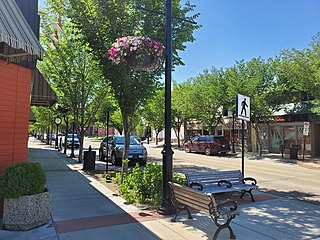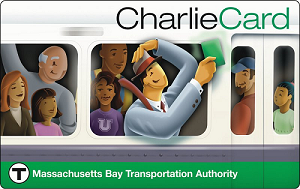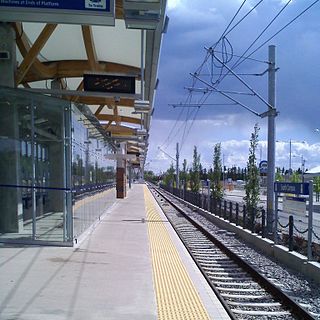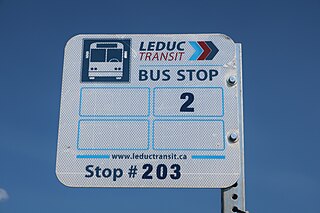
Fort Saskatchewan is a city along the North Saskatchewan River in Alberta, Canada. It is 25 kilometres (16 mi) northeast of Edmonton, the provincial capital. It is part of the Edmonton census metropolitan area and one of 24 municipalities that constitute the Edmonton Metropolitan Region Board. Its population in the 2021 federal census was 27,088.

York Region Transit (YRT) is the public transit operator in York Region, Ontario, Canada. Its headquarters are in Richmond Hill, at 50 High Tech Road.

The Edmonton Transit Service (ETS) is the public transit service owned and operated by the City of Edmonton in Alberta, Canada. It operates Edmonton's bus and light rail systems. In 2022, the system had a ridership of 68,829,300, or about 279,600 per weekday as of the second quarter of 2023.

MiWay, also known as Mississauga Transit and originally as Mississauga Transit Systems, is the municipal public transport agency serving Mississauga, Ontario, Canada, and is responsible to the city's Transportation and Works Department. MiWay services consist of two types of bus routes: MiLocal, local buses that make frequent stops, and MiExpress, express buses between major destinations. MiWay is the primary operator along the Mississauga Transitway, a dedicated east–west bus-only roadway.

The CharlieCard is a contactless smart card used for fare payment for transportation in the Boston area. It is the primary payment method for the Massachusetts Bay Transportation Authority (MBTA) and several regional public transport systems in the U.S. state of Massachusetts.

Edmonton Light Rail Transit, commonly referred to as the LRT, is a light rail system in Edmonton, Alberta. Part of the Edmonton Transit Service (ETS), the system has 18 stations on two lines and 24.3 km (15.1 mi) of track. As of 2018, it is number seven on the busiest light rail transit systems in North America, with over 113,000 daily weekday riders.

Government Centre station is an Edmonton Light Rail Transit station in Edmonton, Alberta, Canada. It serves both the Capital Line and the Metro Line. It is an underground station located beneath 110 Street between 99 Avenue and 98 Avenue. The station provides service to the Government Centre part of the downtown core and the neighbourhood of Oliver. The station is connected to the Alberta Legislature Building and several other government buildings by underground walkways of the Edmonton Pedway.

University station is an Edmonton Light Rail Transit station in Edmonton, Alberta, Canada. It serves both the Capital Line and the Metro Line. It is an underground station located beneath 112 Street at 89 Avenue on the University of Alberta campus. As of 2017, it is the busiest LRT station of the Capital and Metro lines with typical weekday traffic averaging 27,394 passengers.

South Campus/Fort Edmonton Park station is an Edmonton Light Rail Transit station in Edmonton, Alberta. It is served by the Capital Line. It is a ground-level station located on the University of Alberta's South Campus approximately two blocks to the west of the site originally proposed for the station on 113 Street.

Saskatoon Transit is the public transport arm of the City of Saskatoon, Saskatchewan, Canada. It operates a fleet of diesel buses. A total of 23 bus routes serve every area of the city, carrying approximately 11 million passengers in 2008. Saskatoon Transit is a member of the Canadian Urban Transit Association. The major bus terminal is located Downtown.
Transport in Edmonton is fairly typical for a Canadian city of its size, involving air, rail, road and public transit. With very few natural barriers to growth and largely flat to gently rolling terrain bisected by a deep river valley, the city of Edmonton has expanded to cover an area of nearly 768 km2 (297 sq mi), of which only two-thirds is built-up, while the metropolitan area covers around 9,430 km2 (3,640 sq mi). This has resulted in a heavily private transportation-oriented transportation network typical of any other city of its size in North America. However, Edmonton does not have the extensive limited access freeway system typical of what one would find in a US metro area, and the road network is somewhat unusual in regard to access to downtown.

Strathcona County Transit provides local, commuter, and school bus services to the community of Sherwood Park, Alberta, Canada, which is east of Edmonton in Strathcona County. Transportation for elderly citizens and people with disabilities is provided by Mobility Bus within Sherwood Park and rural Strathcona County. Strathcona County is home to Alberta's first fleet of double-decker buses. It purchased 24 double-decker buses from 2010 to 2020 using a combination of municipal, provincial, and federal funding. In 2022, the system had a ridership of 847,300.

St. Albert Transit (StAT) is the public transportation system in the city of St. Albert, Alberta, Canada, which is located about 15 kilometres (9.3 mi) northwest of downtown Edmonton. Scheduled bus service consists of local circuits within the community and express commuter routes to Edmonton. The city owns and maintains the vehicles but the drivers are privately contracted from Diversified Transportation.

The Edmonton trolley bus system formed part of the public transport network in Edmonton, Alberta, Canada between 1939 and 2009. Operated by Edmonton Transit System (ETS), the system had, at its peak, a fleet of 137 trolley buses, and a total route length of 127 km (79 mi).
A reduced fare program refers to special programs providing particular passengers with a discounted fare option for travel on a public transport system. In the United States, public transportation systems that receive federal funding are required to offer, at minimum, half fares to the elderly and handicapped persons during off peak travel. Some transportation systems also extend reduced fare options to youth, students, military personnel, and low-income passengers.

Leduc Transit is public bus system operated by the City of Leduc and Leduc County in the Edmonton Capital Region of Alberta, Canada. The service began on September 8, 2014. The capital investment was 5.16 million dollars CAD. GreenTRIP, a provincial fund to assist public transportation projects, has contributed 3.44 million dollars CAD. The remainder will be divided 65-35 between the City and the County respectively. In 2022, the system had a ridership of 84,300.

The Edmonton Metropolitan Transit Services Commission(EMTSC) was a proposed regional public transit service which was intended to encompass eight municipalities within the Edmonton Metropolitan Region of Alberta, Canada. The EMTSC was dissolved, after the City of Edmonton opted not to provide its share of the annual budget.

The Arc card is a contactless smart card and automated fare collection system being introduced to transit services in the Edmonton Metropolitan Region. The initial launch started in the last week of August, 2021, when U-Pass holders began receiving Arc Cards from their respective institutions. A pilot-testing period with 500 adult fare users began on 1 January, 2022, and the system opened to all adult fare-paying passengers on November 21, 2022. Discounted fare users and special groups will be onboarded to the Arc system at some point in 2023 during phase three, with the specific timeframe depending on the results of the previous phases.
Yorkton Transit is the public transportation service offered in Yorkton, Saskatchewan, Canada. It is provided by the Saskatchewan Abilities Council, who also provides service in Swift Current. The service operates two 12-seat Ford Transit vans on two routes. Service runs Monday to Friday from 7 am to 7 pm, and Saturdays from 9 am to 4 pm. No service is offered on Sundays or holidays. Each line starts service at Livingstone Street, behind the Co-Op grocery store. The North line starts service on the half hour and the South line starts on the hour. Service is in a one-way loop on each line. The North line runs a twice-daily commuter service to the Sask. Abilities offices in the northern industrial area. Service started in 2019, after upgrading from a dial-a-ride program that had been in place since 1995. Service reaches the Yorkton Regional Health Centre and the Gallagher Centre, but not the airport.




















